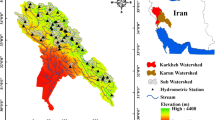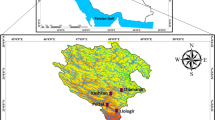Abstract
Accurate prediction of extreme flood peak discharge is essential in developing the best management practices to avoid and reduce flood disaster. In recent years, many techniques have been pronounced as a branch of computer science to model wide range of hydrological process. Nevertheless, exploration of more efficient technique is necessary in terms of accuracy and applicability. In this study, a novel hermite-PPR model with SSO and LS algorithm is proposed for designing annual maximum flood peak discharge forecasting model at Yichang station on Yangtze River in China. The statistical properties of the data series are utilized for identifying an appropriate input vector to the model and then the performance of the proposed models were compared with adaptive neuro-fuzzy inference system (ANFIS), artificial neural network (ANN) and multiple linear regression (MLR) methods in terms of root mean squared error (RMSE), mean absolute relative error (MARE), coefficient of correlation (CC), Nash-Sutcliffe efficiency coefficient (NSEC) and qualified rate (QR). The results indicate that the presented methodology in this research can obtain significant improvement in forecasting accuracy in terms of different evaluation criteria during training and validation phases.



Similar content being viewed by others
References
Blöschl G, Montanari A (2010) Climate change impacts—throwing the dice? Hydrol Process 24(3):374–381
Chau KW, Wu CL, Li YS (2005) Comparison of several flood forecasting models in Yangtze River. J Hydrol Eng 10(6):485–491
Chen XY, Chau KW (2016) A hybrid double feedforward neural network for suspended sediment load estimation. Water Resour Manag 30(7):2179–2194
Cloke HL, Pappenberger F (2009) Ensemble flood forecasting: a review. J Hydrol 375(3–4):613–626
Cuevas E, Cienfuegos M, Zaldivar D, Perez-Cisneros M (2013) A swarm optimization algorithm inspired in the behavior of the social-spider. Expert Syst Appl 40(16):6374–6384
Danandeh Mehr A, Kahya E, Olyaie E (2013) Streamflow prediction using linear genetic programming in comparison with a neuro-wavelet technique. J Hydrol 505:240–249
Dawson CW, Wilby R (1998) An artificial neural network approach to rainfall-runoff modelling. Hydrol Sci J-J Des Sciences Hydrol 43(1):47–66
Dawson CW, Harpham C, Wilby RL, Chen Y (2002) Evaluation of artificial neural network techniques for flow forecasting in the River Yangtze, China. Hydrol Earth Syst Sci 6(4):619–626
Dawson CW, Abrahart RJ, See LM (2007) HydroTest: a web-based toolbox of evaluation metrics for the standardised assessment of hydrological forecasts. Environ Model Softw 22(7):1034–1052
Friedman JH, Stuetzl W (1981) Projection pursuit regression. J Am Stat Assoc 76(376):817–823
Gemmer M, Jiang T, Su B, Kundzewicz ZW (2008) Seasonal precipitation changes in the wet season and their influence on flood/drought hazards in the Yangtze River Basin, China. Quat Int 186(1):12–21
Jang J-SR (1993) ANFIS: Adaptive-network-based fuzzy inference system. IEEE Trans Syst, Man, and Cybernet 23(3):665–685
Jeng-Neng H, Lay SR, Maechler M, Martin RD, Schimert J (1994) Regression modeling in back-propagation and projection pursuit learning. Neural Netw, IEEE Trans 5(3):342–353
Karunanithi N, Grenney WJ, Whitley D, Bovee K (1994) Neural networks for river flow prediction. J Comput Civil Eng - ASCE 8(2):201–220
Latt Z, Wittenberg H (2014) Improving flood forecasting in a developing country: a comparative study of stepwise multiple linear regression and artificial neural network. Water Resour Manag 28(8):2109–2128
Legates DR, McCabe GJ (1999) Evaluating the use of “goodness-of-fit” measures in hydrologic and hydroclimatic model validation. Water Resour Res 35(1):233–241
Li J, Thyer M, Lambert M, Kuczera G, Metcalfe A (2014) An efficient causative event-based approach for deriving the annual flood frequency distribution. J Hydrol 510:412–423
Magar RB, Jothiprakash V (2011) Intermittent reservoir daily-inflow prediction using lumped and distributed data multi-linear regression models. J Earth Syst Sci 120(6):1067–1084
Nash JE, Sutcliffe JV (1970) River flow forecasting through conceptual models part I — a discussion of principles. J Hydrol 10(3):282–290
Quality of nation of P. R. china and Standardization administration of P. R.china (2008) National Standard of the People’s Republic of China, Standard for hydrological information and hydrological forecasting (GB/T 22482–2008). China Water & Power Press, Beijing, pp 5–6
Tripathi R, Sengupta SK, Patra A, Chang H, Jung IW (2014) Climate change, urban development, and community perception of an extreme flood: a case study of Vernonia, Oregon, USA. Appl Geogr 46:137–146
Wang WC, Chau KW, Cheng CT, Qiu L (2009) A comparison of performance of several artificial intelligence methods for forecasting monthly discharge time series. J Hydrol 374(3–4):294–306
Wang WC, Xu DM, Chau KW, Chen SY (2013) Improved annual rainfall-runoff forecasting using PSO-SVM model based on EEMD. J Hydroinf 15(4):1377–1390
Wang WC, Xu DM, Chau KW, Lei GJ (2014) Assessment of river water quality based on theory of variable fuzzy sets and fuzzy binary comparison method. Water Resour Manag 28(12):4183–4200
Wang WC, Chau KW, Xu DM, Chen XY (2015) Improving forecasting accuracy of annual runoff time series using ARIMA based on EEMD decomposition. Water Resour Manag 29(8):2655–2675
Wu MC, Lin GF, Lin HY (2014) Improving the forecasts of extreme streamflow by support vector regression with the data extracted by self-organizing map. Hydrol Process 28(2):386–397
Xu DM, Wang WC, Chau KW, Cheng CT, Chen SY (2013) Comparison of three global optimization algorithms for calibration of the Xinanjiang model parameters. J Hydroinf 15(1):174–193
Yu F, Chen Z, Ren X, Yang G (2009) Analysis of historical floods on the Yangtze River, China: characteristics and explanations. Geomorphology 113(3–4):210–216
Zhang Q, Liu C, Xu CY, Xu Y, Jiang T (2006) Observed trends of annual maximum water level and streamflow during past 130 years in the Yangtze River basin, China. J Hydrol 324(1–4):255–265
Acknowledgments
This research was supported by Public welfare project fund of Ministry of water resources Central Research (201501008), Grant of Hong Kong Polytechnic University (4-ZZAD), National Natural Science Foundation of China (NO:51509088), Program for Science & Technology Innovation Talents in Universities of Henan Province (13HASTIT034), and Science and technology innovation team in Colleges and universities in Henan Province (14IRTSTHN028).
Author information
Authors and Affiliations
Corresponding author
Rights and permissions
About this article
Cite this article
Wang, Wc., Chau, Kw., Xu, Dm. et al. The Annual Maximum Flood Peak Discharge Forecasting Using Hermite Projection Pursuit Regression with SSO and LS Method. Water Resour Manage 31, 461–477 (2017). https://doi.org/10.1007/s11269-016-1538-9
Received:
Accepted:
Published:
Issue Date:
DOI: https://doi.org/10.1007/s11269-016-1538-9




